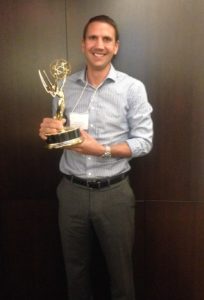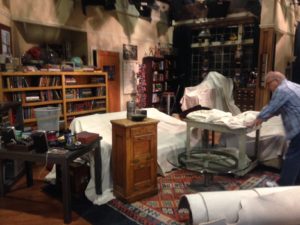This semester CSU students will benefit from lessons learned by a faculty member who attended a special program hosted by the Emmy Awards last fall.
In November 2015, Mark Saunders, an instructor in the Department of Communication Studies, was selected to participate in the Emmys’ 2015 Faculty Seminar. This all-expenses-paid program selects 25 college faculty members from across the nation to participate in a week-long seminar to learn from television’s top professionals. Saunders plans to incorporate what he learned into his classes this fall.
Getting accepted
To be considered for the program, faculty have to submit a letter explaining why they want to attend and how they intend to use their experience to influence their institutions. They also have to submit a resume and a list of the academic courses they are currently teaching. That information is used to narrow down the candidates and determine whether they are a good fit for the program.
After hearing about the opportunity from a colleague at Adams State University who attended the previous year, Saunders decided to apply.
“I knew that this was the chance to increase my understanding of what really goes on behind the scenes of television, while being able to incorporate it into my lesson plans,” said Saunders, a senior teaching special instructor.
He was notified that he had been selected for the program in July 2015 and is the first CSU faculty member to be chosen for the fellowship. The increasing interest in this national, acclaimed seminar has led to limited availability. To ensure that as many colleges and universities in the nation as possible get to participate, the program won’t consider applications from CSU faculty until two years after Saunders’ selection.
About the program
During the program, participants hear from producers, writers, directors and developers about the multiple functions that go into a television show. This includes learning about different genres, sources and development, network and cable decision-making, digital entertainment and new media, new technology and behind-the-scenes features.
“The week was packed with panels, site visits and tours,” Saunders said. “One day I was on the set of Dancing with the Stars, where I saw firsthand the glitz and glam that goes into the show. After talking with the director I could see everything that went into producing it.”
Since there are roughly 400 scripted television shows, according to FX Network, understanding what goes into each show can be helpful to any student interested in the television industry.
“Learning about the behind-the-scenes process of a TV show is more complex than you would think,” Saunders said. “From the lights to the sound, there are so many techniques that are used. The crazy part is that there are so many classic techniques used for how high-tech the industry has become.”
Use in academic classes
Watching television has become a central activity in first-world societies, and understanding its influence on culture, how it has evolved and what goes into it is an important topic in the classes Saunders teaches. Those classes include Pop Culture, Evaluating Contemporary Television and Evaluating Contemporary Film.
“The program was fun and exciting because it provided multiple ways of how to incorporate this information into an academic setting,” Saunders said. “Outside of the rhetoric that is continually used in TV, I can discuss the diverse aspects and what goes into each show.”
In addition to infusing real-world material into his classroom, the experience also reminded Saunders about the value of his work and the passion he has for this industry. Saunders exclaimed, “I love television, and that is why I teach students about it!”